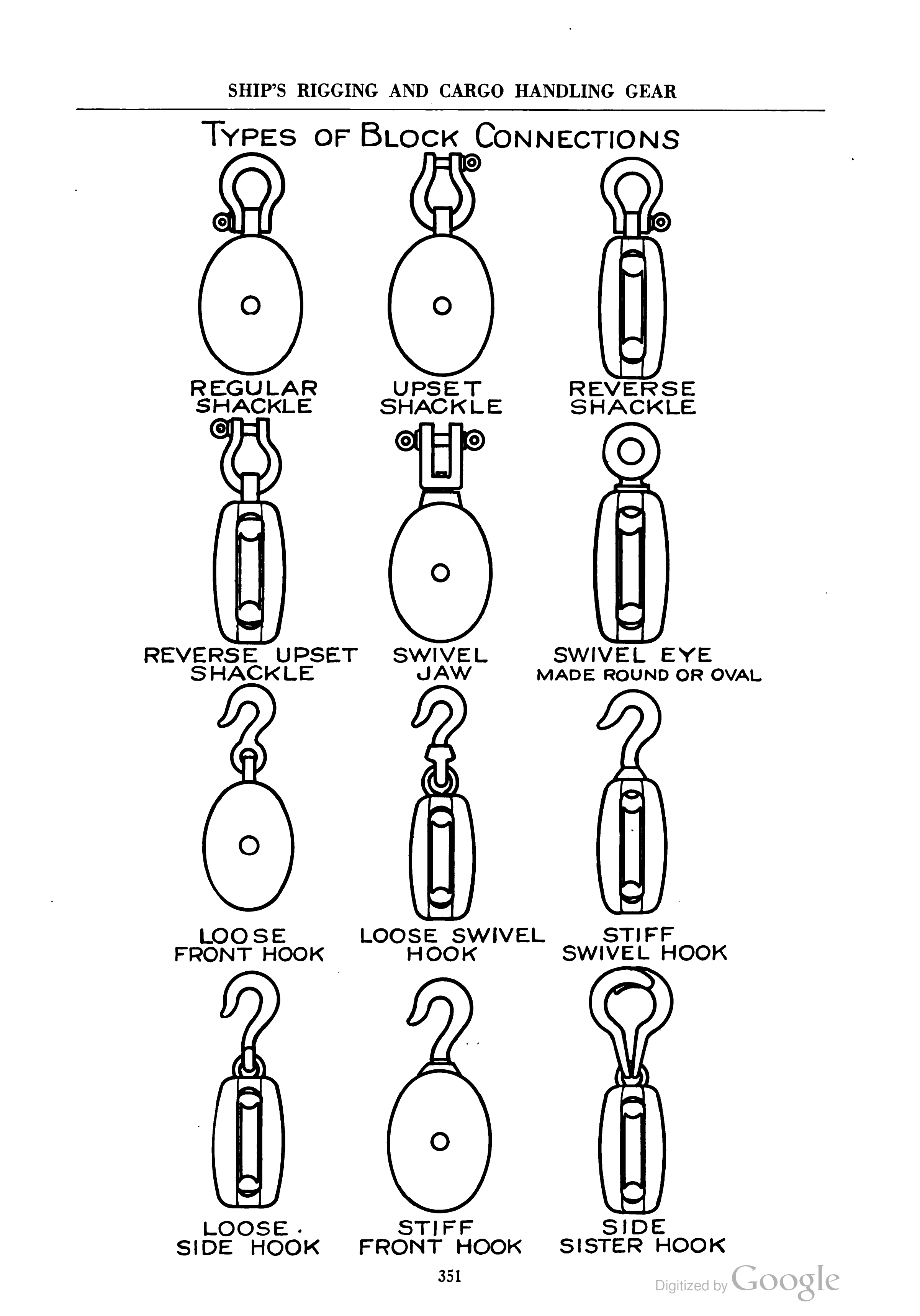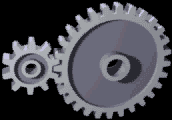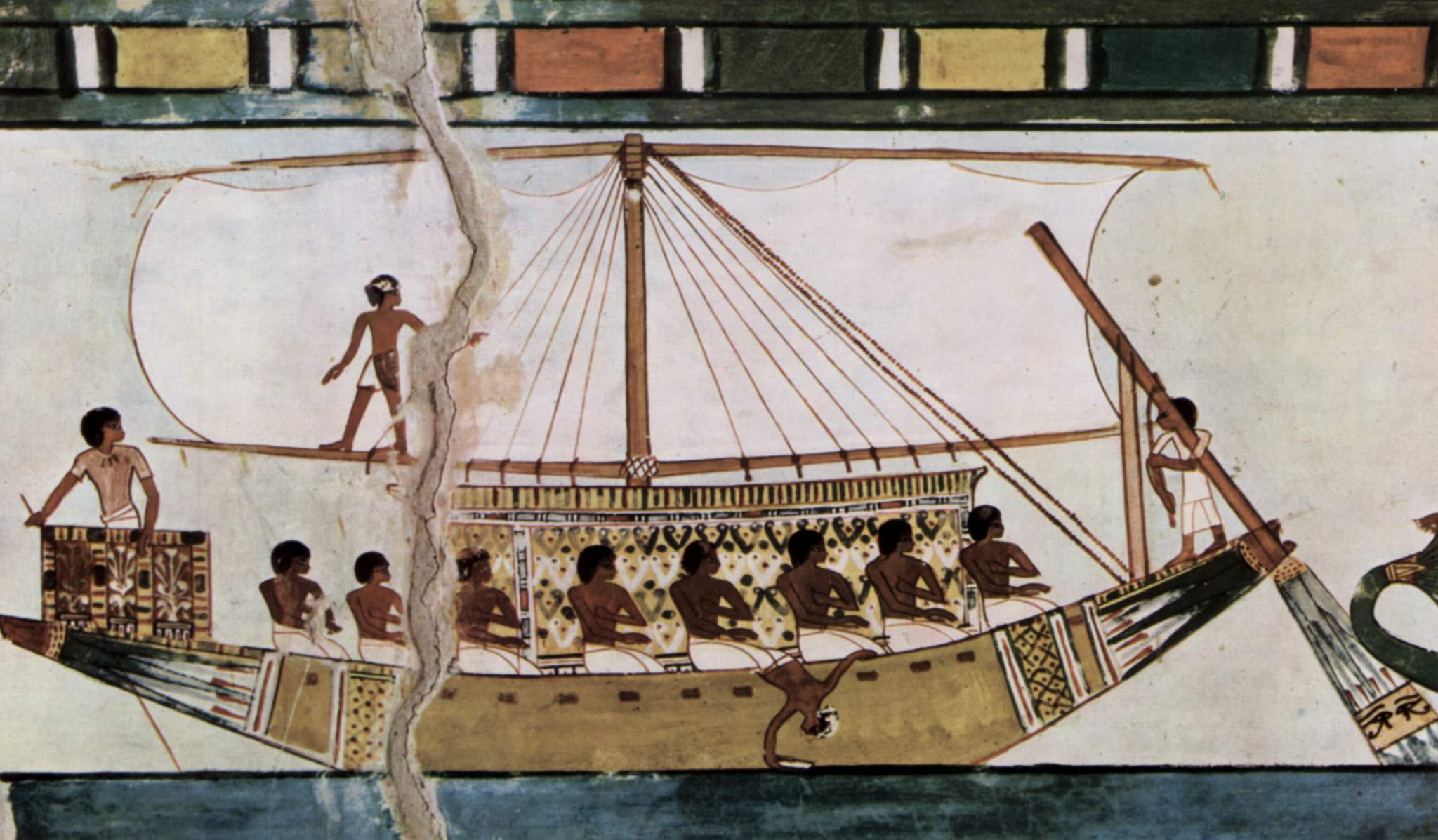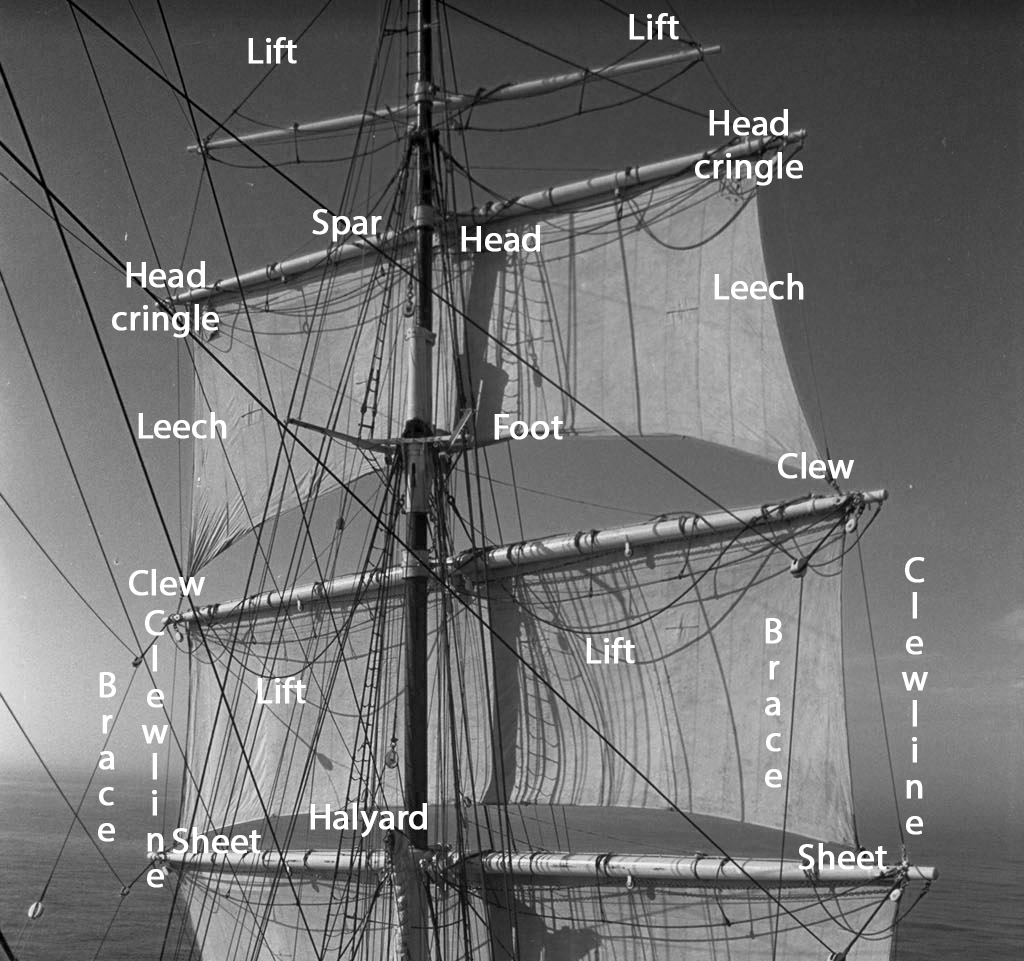|
Clewlines And Buntlines
Clewlines and buntlines are lines used to handle the sails of a square rigged ship. Although the common perception of a traditionally rigged ship is that the sails are handled from "up in the rigging", the majority of the work is actually carried out from the deck. In particular, when sailors go aloft to stow the square sails by bundling them up and tying them to the yard (with gaskets) they don't have to pull the whole weight of the sail up towards them. That work has already been carried out from the deck using the clewlines and the buntlines. As the name suggests, clewlines are attached to the outer corners or clews of the sail. They lift more weight than the buntlines, and also have to pull against the sheets - although these will have been released there is still a certain amount of friction produced by the blocks and fairleads that they run through. For this reason the clewlines are usually fitted with blocks to increase the mechanical advantage. The clewlines are colou ... [...More Info...] [...Related Items...] OR: [Wikipedia] [Google] [Baidu] |
Block (sailing)
In sailing, a block is a single or multiple pulley. One or a number of '' sheaves'' are enclosed in an assembly between ''cheeks'' or ''chocks''. In use, a block is fixed to the end of a line, to a spar, or to a surface. A line (rope) is ''reeved'' through the sheaves, and maybe through one or more matching blocks at some far end, to make up a tackle. The ''purchase'' of a tackle refers to its mechanical advantage. In general the more sheaves in the blocks that make up a tackle, the higher its mechanical advantage. The matter is slightly complicated by the fact that every tackle has a ''working end'' where the final run of rope leaves the last sheave. More mechanical advantage can be obtained if this end is attached to the moving load rather than the fixed end of the tackle. There are various types of blocks that are used in sailing. Some blocks are used to increase mechanical advantage and others are used simply to change the direction of a line. A ''ratchet block'' turn ... [...More Info...] [...Related Items...] OR: [Wikipedia] [Google] [Baidu] |
Belaying Pin
Properly securing a line to a belaying pin starts by leading the line under and behind the base of the pin to begin the figure-8 pattern left, Lines coiled and secured by belaying pins A belaying pin is a solid metal or wooden device used on traditionally rigged sailing vessels to secure lines of running rigging. Largely replaced on most modern vessels by cleats, they are still used, particularly on square rig Square rig is a generic type of sail plan, sail and rigging arrangement in which a sailing ship, sailing vessel's primary driving sails are carried on horizontal spar (sailing), spars that are perpendicular (or wikt:square#Adjective, square) to t ...ged ships. A belaying pin is composed of a round handle and cylindrical shaft. The shaft is inserted into a hole in various strategically located wooden ''pinrails'' (lining the inside of the bulwarks, surrounding the base of masts, or free-standing, called fife rails) up to the base of the handle. A line is then led unde ... [...More Info...] [...Related Items...] OR: [Wikipedia] [Google] [Baidu] |
Ratlines And Sail Handling Lines
Ratlines () are lengths of thin line tied between the shrouds of a sailing ship to form a ladder. Found on all square-rigged ships, whose crews must go aloft to stow the square sails, they also appear on larger fore-and-aft rigged vessels to aid in repairs aloft or conduct a lookout from above. Rat-boards Rat-boards are lower courses in a ratline, often made of slats of wood (batten A batten is most commonly a strip of solid material, historically wood but can also be of plastic, metal, or fiberglass. Battens are variously used in construction, sailing, and other fields. In the lighting industry, battens refer to linea ...s) for support where the distance between shrouds is greatest. In some instances holes in these slats guide and organise low-tension lines between the deck and the rig. Knotting See also * Footrope References {{Sail Types Sailing rigs and rigging ... [...More Info...] [...Related Items...] OR: [Wikipedia] [Google] [Baidu] |
Deadeye
A deadeye is an item used in the standing and running rigging of traditional sailing ships. It is a smallish round thick wooden (usually lignum vitae) disc with one or more holes through it, perpendicular to the plane of the disc. Single and triple-hole deadeyes are most commonly seen. The three-holed blocks were called deadeyes because the position of the three holes resemble the eye and nose sockets of a sheep's skull. Single deadeyes (or bull's eyes) are used to guide and control a line and, particularly in older vessels, to change its direction. More modern systems would use a block for this purpose but in traditional rigs with many lines to deal with, designed when blocks were relatively expensive to make, a deadeye provided an acceptable compromise. When blocks came into common use for adjusting running rigging, deadeyes continued to be used for tensioning standing rigging. Triple deadeyes are used in pairs; a line called a lanyard is run back and forth between them, ... [...More Info...] [...Related Items...] OR: [Wikipedia] [Google] [Baidu] |
Buntline Hitch
The buntline hitch is a knot used for attaching a rope to an object. It is formed by passing the working end around an object, then making a clove hitch around the rope's standing part and taking care that the turns of the clove hitch progress ''towards'' the object rather than away from it. Secure and easily tied, the buntline hitch will jam when subjected to extreme loads. Given the knot's propensity to jam, it is often made in slipped form. History Simple and effective, the buntline hitch dates to the age of sail, when it was used to secure buntlines to the foot of the sailsBrion Toss, ''Chapman's Nautical Guides: Knots'' (New York: Hearst Marine Books, 1990), 39.Clifford W. Ashley, ''The Ashley Book of Knots'' (New York: Doubleday, 1944), 310. on square-rigged ships. That the buntline hitch was the preferred knot speaks to its security and reliability.Geoffrey Budworth, ''The Complete Book of Knots'' (London: Octopus, 1997), 51. Once set, repeated jerking and slatt ... [...More Info...] [...Related Items...] OR: [Wikipedia] [Google] [Baidu] |
Mechanical Advantage
Mechanical advantage is a measure of the force amplification achieved by using a tool, mechanical device or machine system. The device trades off input forces against movement to obtain a desired amplification in the output force. The model for this is the ''law of the lever.'' Machine components designed to manage forces and movement in this way are called mechanisms. An ideal mechanism transmits power without adding to or subtracting from it. This means the ideal machine does not include a power source, is frictionless, and is constructed from rigid bodies that do not deflect or wear. The performance of a real system relative to this ideal is expressed in terms of efficiency factors that take into account departures from the ideal. Levers The lever is a movable bar that pivots on a fulcrum attached to or positioned on or across a fixed point. The lever operates by applying forces at different distances from the fulcrum, or pivot. The location of the fulcrum deter ... [...More Info...] [...Related Items...] OR: [Wikipedia] [Google] [Baidu] |
Fairlead
A fairlead is a turning point for running rigging like rope, chain, wire or line, that guides that line such that the "lead" is "fair", and therefore low friction and low chafe. A fairlead can be a hook, ring, pulley, chock, or hawse (hole) sometimes surrounded by rollers. If the line is meant to be moved while in the fairlead, the angle in the line created by the fairlead must be shallow to minimize friction. For larger angles a block or pulley is used as a fairlead to reduce friction. Where the line is removed from a hook fairlead before using, the angle is not an issue. A fairlead can also be used to stop a straight run of line from vibrating or rubbing on another surface. Fairleads are used on most sailboats. Even a simple Sunfish sailboat has two fairleads. A ring fairlead holds the halyard parallel to the mast so its cleat can be located near to the cockpit. On models without a deck block for the sheet, a hook fairlead in the forward edge of the cockpit gives the sai ... [...More Info...] [...Related Items...] OR: [Wikipedia] [Google] [Baidu] |
Sail
A sail is a tensile structure, which is made from fabric or other membrane materials, that uses wind power to propel sailing craft, including sailing ships, sailboats, windsurfers, ice boats, and even sail-powered land vehicles. Sails may be made from a combination of woven materials—including canvas or polyester cloth, laminated membranes or bonded filaments, usually in a three- or four-sided shape. A sail provides propulsive force via a combination of lift and drag, depending on its angle of attack, its angle with respect to the apparent wind. Apparent wind is the air velocity experienced on the moving craft and is the combined effect of the true wind velocity with the velocity of the sailing craft. Angle of attack is often constrained by the sailing craft's orientation to the wind or point of sail. On points of sail where it is possible to align the leading edge of the sail with the apparent wind, the sail may act as an airfoil, generating propulsive force as air pa ... [...More Info...] [...Related Items...] OR: [Wikipedia] [Google] [Baidu] |
Sheet (sailing)
In sailing, a sheet is a line (rope, cable or chain) used to control the movable corner(s) (clews) of a sail. Terminology In nautical usage the term "sheet" is applied to a line or chain attached to the lower corners of a sail for the purpose of extension or change of direction. The connection in derivation with the root "shoot" is more clearly seen in "sheet-anchor", one that is kept in reserve, to be "shot" in case of emergency. Fore-and-aft rigs Fore-and-aft rigs comprise the vast majority of sailing vessels in use today, including effectively all dinghies and yachts. The sheet on a fore-and-aft sail controls the angle of the sail to the wind, and should be adjusted to keep the sail just filled. Most smaller boats use the Bermuda rig, which has two or three sets of sheets: * The mainsheet is attached to the boom, and is used to control the mainsail. In a rig with no boom on the mainsail, the mainsheet would attach directly to the mainsail clew. A mainsheet is a line con ... [...More Info...] [...Related Items...] OR: [Wikipedia] [Google] [Baidu] |
Parts Of A Sail
Sail components include the features that define a sail's shape and function, plus its constituent parts from which it is manufactured. A sail may be classified in a variety of ways, including by its orientation to the vessel (e.g. ''fore-and-aft'') and its shape, (e.g. ''(a)symmetrical'', ''triangular'', ''quadrilateral'', etc.). Sails are typically constructed out of flexible material that is shaped by various means, while in use, to offer an appropriate airfoil, according to the strength and apparent direction of the wind. A variety of features and fittings allow the sail to be attached to lines and spars. Whereas conventional sails form an airfoil with one layer of fabric, wingsails comprise a structure that has material on both sides to form an airfoil—much like a wing placed vertically on the vessel—and are beyond the scope of this article. Classifications Sails may be classified as either ''triangular'', which describes sails that either come to one point of suspen ... [...More Info...] [...Related Items...] OR: [Wikipedia] [Google] [Baidu] |






